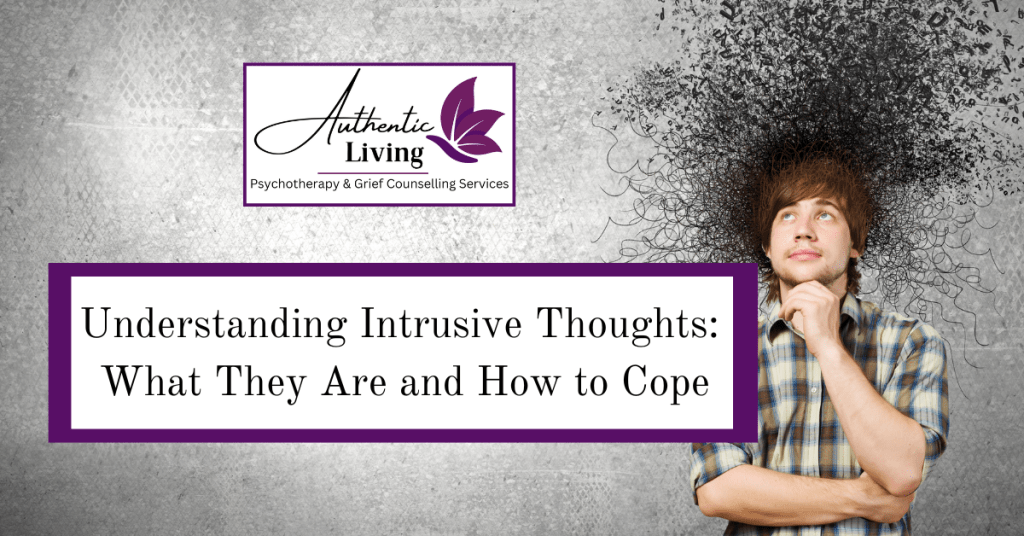Most people experience intrusive thoughts at some point—those sudden, unwanted, and often distressing ideas that seem to come out of nowhere. Whether it’s an image, urge, or fear that feels disturbing or out of character, these thoughts can leave us feeling confused, ashamed, or even frightened. But the truth is, intrusive thoughts are a normal part of human experience.
In this post, we’ll take a look at intrusive thoughts—exploring their neurological, biological, psychological, and sociological roots, and offering concrete strategies for managing them and responding with self-compassion.
What Are Intrusive Thoughts?
Intrusive thoughts are unwanted, involuntary thoughts, images, or impulses that can be disturbing, violent, sexual, or just plain odd. They often appear suddenly, without context, and can be difficult to control or dismiss. Common intrusive thoughts include:
Fear of harming someone
Doubts about your morality or identity
Unwanted sexual images or impulses
Obsessions about contamination or illness
Fear of acting on impulse (e.g., blurting something inappropriate)
Important to note: having an intrusive thought does not mean you want it, believe it, or will act on it.
The Neurology of Intrusive Thoughts
Intrusive thoughts originate in the brain’s default mode network (DMN)—a set of interconnected regions that become active when the mind is at rest. The prefrontal cortex, which helps regulate judgment and self-control, also plays a role in either suppressing or reacting to these thoughts.
For some, overactivity in the amygdala—the brain’s fear center—can make these thoughts feel especially emotionally charged. In conditions like OCD (Obsessive Compulsive Disorder) or PTSD, there’s often a dysregulated feedback loop between the amygdala, prefrontal cortex, and anterior cingulate cortex, which processes errors or perceived “threats.”
This explains why intrusive thoughts can feel so urgent or “real,” even though they’re just thoughts.
The Biology Behind Intrusive Thoughts
On a biological level, intrusive thoughts are linked to stress hormones like cortisol and adrenaline. When we’re under stress, our brains become more vigilant, scanning for danger—even imaginary danger. This heightened state of arousal increases the likelihood of bizarre or fear-based thoughts popping into awareness.
Additionally, neurotransmitters like serotonin are involved in mood regulation and mental flexibility. Imbalances in serotonin have been connected to conditions like OCD, anxiety, and depression—all of which can heighten or prolong intrusive thinking.
Sleep deprivation, hormonal changes (e.g., postpartum or perimenopause), substance use, and physical health issues can also contribute to the frequency and intensity of intrusive thoughts.
The Psychology of Intrusive Thoughts
Psychologically, intrusive thoughts often gain power when we assign meaning to them. For example, if you think, “What if I push someone in front of a train?” and then panic, “Does this mean I’m dangerous?”, your brain starts treating the thought like a real threat.
This is known as thought-action fusion—believing that having a bad thought is morally equivalent to doing a bad thing. This distorted thinking fuels anxiety and often leads to avoidance or compulsive behaviors.
In therapy, especially approaches like Cognitive Behavioural Therapy (CBT) or Exposure and Response Prevention (ERP), clients learn to recognize these thoughts as just mental noise—not warnings, intentions, or reflections of identity.
The Sociological Lens: What Society Tells Us About Our Thoughts
Society often teaches us to fear our minds, especially when our thoughts challenge cultural norms or ideals. We’re told to “think positively,” or that “bad thoughts mean you’re a bad person.” This leads to stigma and shame, particularly around thoughts that involve taboo topics like violence or sex.
Certain groups are more affected by this social messaging:
Mothers with postpartum intrusive thoughts are often terrified to disclose them for fear of being seen as unfit parents.
Religious individuals may interpret intrusive blasphemous thoughts as spiritual failings.
Men may feel especially ashamed of thoughts that contradict traditional ideas of masculinity or control.
Understanding the social context can help reduce shame and foster compassionate, nonjudgmental conversation about mental health.
How to Break the Cycle of Intrusive Thoughts
1. Label the Thought
Say to yourself, “That’s just an intrusive thought.” This simple label reminds you that thoughts are not facts and don’t require action.
2. Avoid Engaging
Resist the urge to analyze, argue with, or try to suppress the thought. Mental rituals and reassurance-seeking actually reinforce the cycle.
3. Let it Be
Let the thought exist in the background, like static on a radio. It’s uncomfortable, but not dangerous. It will pass.
4. Practice Exposure
If certain thoughts keep coming back, exposure therapy—gently allowing the thought to be there without reacting—can help desensitize your brain over time.
5. Ground Yourself
Use grounding exercises to shift attention away from the thought and into the present. For example:
Name 5 things you see
Take 3 deep belly breaths
Feel your feet on the floor
6. Limit Stress
Because stress fuels intrusive thoughts, prioritize:
Quality sleep
Movement or exercise
Time outdoors
Balanced nutrition
How to Be Kind to Yourself About Intrusive Thoughts
The way you talk to yourself about your intrusive thoughts matters. Shame feeds the cycle. Compassion breaks it.
Here are a few reminders to help you be kind to yourself:
You are not your thoughts.
The brain throws out random, weird, even disturbing ideas all the time. This is normal.You’re not alone.
Millions of people experience intrusive thoughts. You are not broken, and you don’t need to be afraid.Thoughts don’t define your character.
What matters is how you choose to respond—not what randomly pops into your head.It’s okay to ask for help.
Talking to a therapist—especially one trained in OCD, anxiety, or trauma—can help you learn tools to manage intrusive thoughts and reduce distress.
When to Seek Professional Help
Intrusive thoughts become more than just a nuisance when they:
Interfere with daily life
Cause extreme distress or shame
Lead to compulsions, avoidance, or isolation
Feel persistent and uncontrollable
If that sounds like your experience, you’re not alone—and therapy can help. At Authentic Living London, our trained professionals create a safe, nonjudgmental space to talk about even the most difficult thoughts. You deserve support that understands your struggle.
Intrusive thoughts are scary not because of what they are, but because of what we think they mean. But they’re not predictions, truths, or reflections of who you are. They’re just mental junk—like spam email.
You are allowed to have a messy, unpredictable mind and still be a good, kind, whole person. Let’s stop shaming ourselves for having a human brain—and start treating ourselves with the compassion we deserve.
Need support?
Reach out to us at Authentic Living London to learn how therapy can help you navigate intrusive thoughts with clarity, confidence, and kindness.

Lizanne Hills
Registered Psychotherapist -Qualifying Addictions Certificate
Areas of Focus: Grief, Addictions, Family Therapy, Couples Therapy, Trauma/PTSD, Children’s Grief, Autism Spectrum Disorder, Life Transitions





